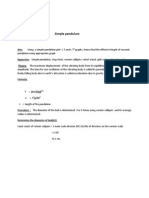Simple Pendulum
Simple Pendulum
Uploaded by
ASNCopyright:
Available Formats
Simple Pendulum
Simple Pendulum
Uploaded by
ASNOriginal Description:
Original Title
Copyright
Available Formats
Share this document
Did you find this document useful?
Is this content inappropriate?
Copyright:
Available Formats
Simple Pendulum
Simple Pendulum
Uploaded by
ASNCopyright:
Available Formats
Practical Study Material Physics Practical Study Material Physics
Find the acceleration due to gravity (g) at your place using Simple Draw l - T2 graph in the case of a Simple Pendulum and find the
7 Pendulum. Draw l - T2 graph and verify the value of g with the
value obtained from the graph. (Take 6 observations)
2 l
8 length of the seconds pendulum. (Take 6 observations.)
Formula: Acceleration due to gravity, g 2 cm/s2 l - T2 graph: A graph is drawn between l on the
T
where g = Acceleration due to gravity in cm/s2 T2
X-axis and T 2 on the Y-axis. The graph is a
T2
l = Length of the pendulum in cm straight line passing through the origin. From graph,
Kapil
Kapil
T = Time period in cm the value of l/T2 and hence ‘g’ can be calculated.
4 2 This value should be equal to the value obtained
Acceleration due to gravity by graph, g cm/s2 l previously.
m l
where m = slope of the line Procedure:
l/T2 graph: A graph is drawn between l on the X-axis and T2 on the Y-axis. The
graph is a straight line passing through the origin. From graph, the value of l/T2 and 1) The diameter of the bob is determined 3 or 4 times using a vernier calipers
hence ‘g’ can be calculated. This value should be equal to the value obtained previously. and its average radius ‘r’ is determined.
Procedure: 2) The length of the pendulum is adjusted to a convenient value, say 50 cm.
1) The diameter of the bob is determined 3 or 4 times using a vernier calipers 3) The bob is drawn to a side giving small amplitude and released. Then it
and its average radius ‘r’ is determined. begins to oscillate in the same vertical plane.
2) The length of the pendulum is adjusted to a convenient value, say 50 cm. 4) After the first few swings, a stop- clock is started. At the end of the 20
oscillations, the stop-clock is stopped and the time for 20 oscillations is noted.
3) The bob is drawn to a side giving small amplitude and released. Then it
begins to oscillate in the same vertical plane. 5) The experiment is repeated twice and the mean time for 20 oscillations
determined. The mean time is divided by 20 to get the time taken for one
4) After the first few swings, a stop- clock is started. At the end of the 20 oscillation or period T.
oscillations, the stop-clock is stopped and the time for 20 oscillations is noted.
6) Readings are noted in the below table.
5) The experiment is repeated twice and the mean time for 20 oscillations
determined. The mean time is divided by 20 to get the time taken for one Precautions:
oscillation or period T. 1. The amplitude should not exceed more than 5o.
6) Readings are noted in the below table. 2. The bob should not spin as it oscillates in the vertical plane.
Precautions: Observations:
1. The amplitude should not exceed more than 5o.
Diameter of the bob:
2. The bob should not spin as it oscillates in the vertical plane.
Observations: S.No M.S.R V.C.D Total reading
Diameter of the bob: (a) cm (n) a (n L.C) in cm
S.No M.S.R V.C.D Total reading
(a) cm (n) a (n L.C) in cm
Kapil
Kapil
Average diameter of the bob D = 2r =
The radius of the bob, r = D/2 =
Average diameter of the bob D = 2r =
The radius of the bob, r = D/2 =
You might also like
- Compound Pendulum Lab ReportDocument13 pagesCompound Pendulum Lab ReportMuhammad Faizan Tariq57% (14)
- Pendulum ExpDocument4 pagesPendulum ExpRoyston EbenezerNo ratings yet
- Compound PendulumDocument4 pagesCompound Pendulumamit100% (2)
- JobDocument4 pagesJobJoseph ChamorroNo ratings yet
- Physics EXPERIMENTs Term2Document6 pagesPhysics EXPERIMENTs Term2cutuNo ratings yet
- Lab Manual Compete-Waves and MechanicsDocument64 pagesLab Manual Compete-Waves and MechanicsMuhammad SaqibNo ratings yet
- Physics BSC Lab ManualDocument51 pagesPhysics BSC Lab Manualmarshallps0077No ratings yet
- Simple PendulumDocument3 pagesSimple PendulumTapajit GhoshNo ratings yet
- Simple Pendulum ExperimentDocument5 pagesSimple Pendulum ExperimentrezzmanNo ratings yet
- Exp - 4 Simple Pendulum PDFDocument4 pagesExp - 4 Simple Pendulum PDFyaswanthNo ratings yet
- Lab Manual Xi - 3Document5 pagesLab Manual Xi - 3complaintomagmaNo ratings yet
- Simple PendulumDocument5 pagesSimple PendulumReshan ChowdhuryNo ratings yet
- Experiment 7 Grade 11Document4 pagesExperiment 7 Grade 11Varnit MehraNo ratings yet
- Experiment - 4 - Bar Pendulum and Kater's PendulumDocument20 pagesExperiment - 4 - Bar Pendulum and Kater's PendulumDev Halvawala100% (1)
- XIIth Manual 2010Document22 pagesXIIth Manual 2010kiranpatel0100% (1)
- B.Tech Engg Phy Practical Manual PDFDocument36 pagesB.Tech Engg Phy Practical Manual PDFAshim BasumataryNo ratings yet
- Simple PendulumDocument2 pagesSimple Pendulumuvasri1211No ratings yet
- Physics Lab Manual - Class 11 Experiment No. 4Document4 pagesPhysics Lab Manual - Class 11 Experiment No. 4masterjedi1008No ratings yet
- Simple PendulumDocument5 pagesSimple Pendulumpiyushdua01No ratings yet
- Practical 3Document2 pagesPractical 3foryNo ratings yet
- Chemistry PHY 1208 Lab Manual 2023Document36 pagesChemistry PHY 1208 Lab Manual 2023akterfarida062No ratings yet
- Experiment: Period of PendulumDocument3 pagesExperiment: Period of Pendulumilifatimah.arNo ratings yet
- Experiment No. 7 Simple PendulumDocument2 pagesExperiment No. 7 Simple PendulumKrish PatelNo ratings yet
- Bar PendulumDocument4 pagesBar Pendulumvidhiichauhan7No ratings yet
- Exp 5 Simple PendulumDocument2 pagesExp 5 Simple PendulumPriti UpadhyayNo ratings yet
- Python BasicsDocument2 pagesPython BasicsNeelam KapoorNo ratings yet
- Unit C P3-1Document3 pagesUnit C P3-1th4417085No ratings yet
- Expt- 4 Simple PendulumDocument2 pagesExpt- 4 Simple PendulumpmariathresaNo ratings yet
- 2.rigidity ModulusDocument4 pages2.rigidity Modulusmanas100% (1)
- Assignment HW P 1 9 Rotational DynamicsDocument1 pageAssignment HW P 1 9 Rotational Dynamicsbediavneesh04No ratings yet
- Experiment 1.1 (FZ F4)Document2 pagesExperiment 1.1 (FZ F4)Izzati AnuarNo ratings yet
- Waves Practical 2025 EnglishDocument18 pagesWaves Practical 2025 EnglishbhemasarmaNo ratings yet
- Qdoc - Tips Bar PendulumDocument11 pagesQdoc - Tips Bar PendulumKrisha Mae ChaNo ratings yet
- Indian School of Physics: The Goal of Education Is The Advancement of Knowledge and The Dissemination of TruthDocument63 pagesIndian School of Physics: The Goal of Education Is The Advancement of Knowledge and The Dissemination of TruthPrashant GargNo ratings yet
- Physics Assignment Help - Calculating Gravity Using Simple PendulumDocument2 pagesPhysics Assignment Help - Calculating Gravity Using Simple PendulumExpertsmindEduNo ratings yet
- Hsslive XI Physics ResonanceColumn1Document2 pagesHsslive XI Physics ResonanceColumn1Saajan MaharjanNo ratings yet
- Physics Project XIDocument10 pagesPhysics Project XIanishkadiyalaNo ratings yet
- Bar PendulumDocument11 pagesBar PendulumDaniel Miller66% (35)
- Physics Locf SyllabusDocument39 pagesPhysics Locf Syllabustejnaik20No ratings yet
- Manual of SIMPLE PENDULUM PDFDocument3 pagesManual of SIMPLE PENDULUM PDFNone Of your businessNo ratings yet
- Experiment 4Document5 pagesExperiment 4dummy008No ratings yet
- Compound PendulumDocument6 pagesCompound PendulumRajaul Morshad SaikotNo ratings yet
- Year 10 Experiment 1 Simple PendulumDocument4 pagesYear 10 Experiment 1 Simple PendulumLawrence Onthuga100% (1)
- Experiment No.1Document4 pagesExperiment No.1SUPER CLASHNo ratings yet
- Determine G by Using Simple PendulumDocument3 pagesDetermine G by Using Simple PendulumMohammad Sahedul MarufNo ratings yet
- Linear and Angular VelocityDocument17 pagesLinear and Angular VelocityMK KM100% (2)
- Accleration Due To Gravity by Bar PendulumDocument3 pagesAccleration Due To Gravity by Bar PendulumSumit BagdeNo ratings yet
- Manual of Medical PhysicsDocument18 pagesManual of Medical Physicsأ. علي محمدNo ratings yet
- Simplependulum PDFDocument3 pagesSimplependulum PDFNaledi NaledyNo ratings yet
- EEE - MPE - IPE Lab ManualDocument44 pagesEEE - MPE - IPE Lab Manualfisherman.psychNo ratings yet
- Manual of Medical Physics PDFDocument48 pagesManual of Medical Physics PDFAli AlengineerNo ratings yet
- T L T L G: Experiment E4Document4 pagesT L T L G: Experiment E4Yuv RajNo ratings yet
- Experiment 5 Title: Acceleration of Free Fall by Means of The Simple Pendulum. ObjectiveDocument2 pagesExperiment 5 Title: Acceleration of Free Fall by Means of The Simple Pendulum. ObjectiveReam MairNo ratings yet
- Practical No 4Document5 pagesPractical No 4Mahin SarkarNo ratings yet
- Simple PendulumDocument9 pagesSimple PendulumSajayan Kaniyoduthekkil SomanNo ratings yet
- Eee 102 - Exp-3 - 233001310Document6 pagesEee 102 - Exp-3 - 233001310nahianrahman0011No ratings yet
- Simple PendulumDocument5 pagesSimple Pendulumv sharvan kumar asst.prof(mech)No ratings yet
- Experiment 1.1 (Fz F4)Document2 pagesExperiment 1.1 (Fz F4)Izzati AnuarNo ratings yet
- Unofficial Physics Challenge ProblemsDocument5 pagesUnofficial Physics Challenge ProblemsAhmed Saad SabitNo ratings yet
- Aps 4101 Sep-Dec 2024Document9 pagesAps 4101 Sep-Dec 2024nyaonchabenjaminNo ratings yet
- Bulky Knit Wraps & Cowls: 9 Quick, Cozy KnitsFrom EverandBulky Knit Wraps & Cowls: 9 Quick, Cozy KnitsRating: 5 out of 5 stars5/5 (1)
- Quality Policy Nestle PDFDocument6 pagesQuality Policy Nestle PDFJonathan KacouNo ratings yet
- Chapter 20 PowerPointDocument18 pagesChapter 20 PowerPointfitriawasilatulastifahNo ratings yet
- Caro - Presentation of A CAA Formulation Based On Ligthills Analogy For Fan NoiseDocument10 pagesCaro - Presentation of A CAA Formulation Based On Ligthills Analogy For Fan Noiseruffnex_86No ratings yet
- Selling SkillsDocument18 pagesSelling SkillsSaher KapdiNo ratings yet
- Template CHN DutyDocument7 pagesTemplate CHN DutyKrissel Tisha LopezNo ratings yet
- CapgeminiDocument8 pagesCapgeminiAnjani Kumar RaiNo ratings yet
- C293 PDFDocument3 pagesC293 PDFHassan MokhtarNo ratings yet
- TGS Besar ML 8488 8684 8861 9010 9027Document8 pagesTGS Besar ML 8488 8684 8861 9010 9027SisdigNo ratings yet
- Fate Wearing The Cape - OCR PDFDocument33 pagesFate Wearing The Cape - OCR PDFJeferson Moreira100% (1)
- Energy and Power Generation Handbook PDFDocument44 pagesEnergy and Power Generation Handbook PDFJ David González100% (2)
- MANUAL Enotifikasi Versi BaruDocument51 pagesMANUAL Enotifikasi Versi BaruVince OtungNo ratings yet
- DLL HeleDocument6 pagesDLL HeleAllen DimapilisNo ratings yet
- Statistics Chapter 6c (Poisson Probability)Document16 pagesStatistics Chapter 6c (Poisson Probability)Majid JamilNo ratings yet
- Class 11 Ws 1Document2 pagesClass 11 Ws 1radhikasingh4788No ratings yet
- Chapter 2 PPT (AIS - James Hall)Document5 pagesChapter 2 PPT (AIS - James Hall)Nur-aima MortabaNo ratings yet
- A Guide To: Postgraduate StudyDocument24 pagesA Guide To: Postgraduate StudyLeslie WilliamsNo ratings yet
- Unconfined Compressive Strength of SoilDocument4 pagesUnconfined Compressive Strength of SoilJoshi DhvanitNo ratings yet
- Mindmap QTMKTDocument21 pagesMindmap QTMKTmyvo2201No ratings yet
- SommerfiledDocument17 pagesSommerfiledSugnik MondalNo ratings yet
- Placemaking Booklet PDFDocument24 pagesPlacemaking Booklet PDFsylviarola3511100% (5)
- Site ReportDocument2 pagesSite ReportTracy ChambersNo ratings yet
- Course OutlineDocument5 pagesCourse Outlinekc103038No ratings yet
- Fujinon GX-M Lenses Comparison PDFDocument1 pageFujinon GX-M Lenses Comparison PDFfralgiugiaNo ratings yet
- Winkler Method For Dissolved Oxygen AnalysisDocument5 pagesWinkler Method For Dissolved Oxygen AnalysisAngeli FacunNo ratings yet
- Standard Calibration Procedure Pick Glass Doc. No. Call/SCP/010 Rev. 00 May 01, 2015Document4 pagesStandard Calibration Procedure Pick Glass Doc. No. Call/SCP/010 Rev. 00 May 01, 2015Ajlan KhanNo ratings yet
- Review Test - English - Grade X - Chapter 2Document4 pagesReview Test - English - Grade X - Chapter 2Harini PahlawatiningsihNo ratings yet
- Final Paper Analysis-SportsleadershipDocument8 pagesFinal Paper Analysis-Sportsleadershipapi-719380317No ratings yet
- Tutorial 5Document2 pagesTutorial 5Bach Tran HuuNo ratings yet
























































































